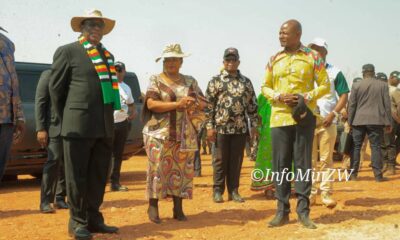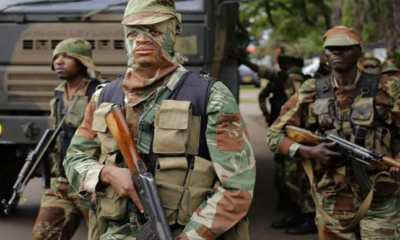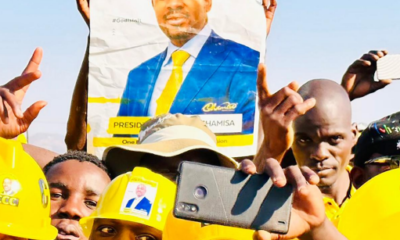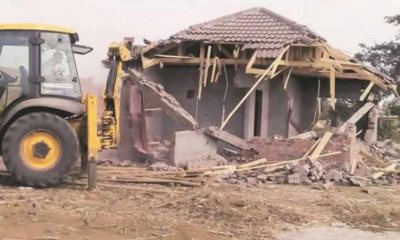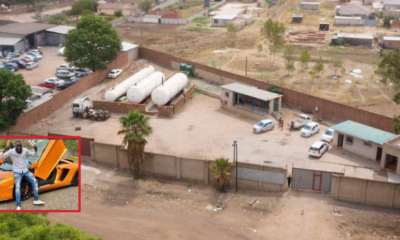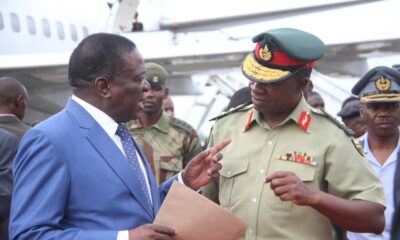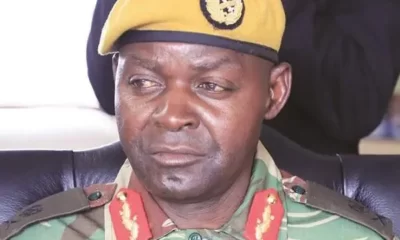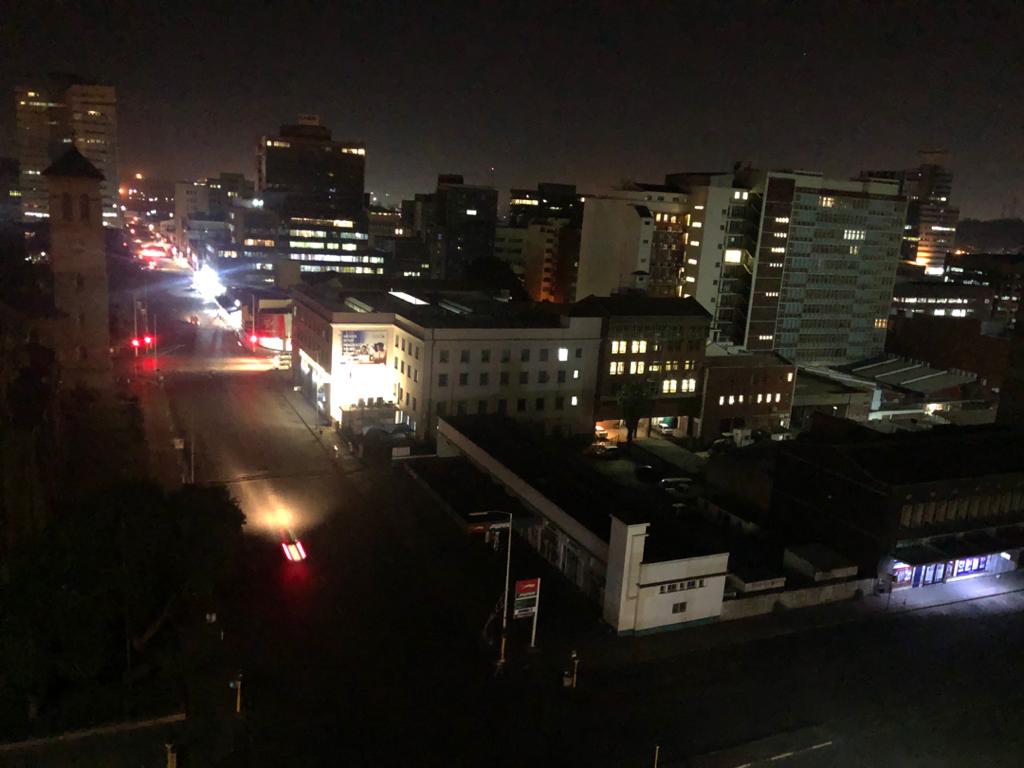
Opinion
Geographies of urban dominance
Published
4 years agoon
By
NewsHawks…the politics of Harare’s periphery
By JoAnne McGregor and Kudzai Chatiza
This paper examines how Zimbabwe’s ruling party Zanu PF sought to dominate Harare from 2000 onwards, when the city’s voters turned to the opposition Movement for Democratic Change (MDC).
The ruling party’s quest for control was embedded in broader changes to the state, marked by countrywide repression of the political opposition and civic organisations, securitised state institutions, and a shift into patronage and systemic corruption, in a context of repeated economic crises and infrastructural decay. Zanu PF deployed a mix of “repressive” and “generative” strategies but these have been notably unsuccessful in winning back urban votes overall. The ruling party’s “generative” patronage in this solidly opposition-supporting capital hinged on controlling land and new settlements on the periphery, together with dominance of central markets and opportunities for vending. Simultaneously, the powers of the ministry responsible for Local Government were used to undermine the city’s council, destabilise its finances and restrict its spatial governance. Land reform and land occupations, justified nationwide as a continuation of the liberation struggle, shaped the city’s expansion in distinctive ways.
The paper makes two contributions to broader conceptual debates over political dominance in urban contexts. First, it advocates a geographical approach that differentiates specific urban spaces, rather than treating capital cities as monolithic. Second, it calls for attention to the qualities of political dominance and change over time. This means looking beyond top-down strategies of co-optation or coercion and open forms of protest politics to explore authority and political manoeuvres within dominated locales.
Introduction
Harare has been a solidly opposition-supporting city from the year 2000. The ruling party’s quest for dominance over the past two decades has thus failed in the capital, as voters have repeatedly returned opposition MPs and councillors. Here we examine the strategies that have characterised Zanu PF’s quest to dominate Harare, focusing on the politics of urban spaces where there was some success, namely new settlements on the city periphery. The emergence of ruling party dominated city-edge settlements needs to be situated in Zanu PF’s broader nationwide repression and shift into patronage politics, which had a significant populist redistributive element, including through land reform and land occupations. Occupations were fuelled by unmet urban housing demand by the homeless and other urbanites mobilising themselves to take advantage of politicised opportunities for access to land. The paper makes two contributions to broader debates on the politics of urban dominance. First, it calls for a geographical approach to capital cities, rather than presenting them as monolithic. This draws attention to how, in opposition-supporting cities, where the ruling party has failed to dominate overall, it can nonetheless control certain spaces – in the Harare case, peripheral lands, new settlements and central markets. Thinking spatially about urban dominance demands attention to how centralised ruling party/state institutions relate to authority and contestation within these specific sites. We extend Zimbabwean debates over urban land and land reform.
We do so by examining the history of new politicised settlements on the urban periphery. As broader urban scholarship attests, messy legal and bureaucratic formalities matter, even when honoured only in their breach, as they shape practices of claim-making and authority A permissive policy framework and partisan interests underpinned the emergence of Zanu PF “land barons” and ruling party committees acting as territorial authorities on the city edge. The stand-off between state bodies, none of which wanted responsibility for the costs of servicing new settlements, created a regulatory gap and perpetuated the ruling party’s de facto territorial powers, allowing residents’ protracted insecurity to be exploited to party political ends. Yet this strategy had limits: as settlements grew, endured and densified, their sheer scale increasingly mitigated against the prospect of wholescale demolition, while residents’ unrelenting pressure influenced prospects for recognition and greater tenure security. Second, and related to the above, the chapter calls for attention to the quality of party-political domination, lest the term itself imply undue fixity, solidity or stability. In Harare, even in those spaces where Zanu PF can be said to dominate, this domination is far from total. Performances of Zanu PF support were often hollow, the party has faced overt challenges as well as being riven by internal factional struggles. Political dominance can be slowly chipped away from the bottom up through tactics of clientelist engagement on the part of ordinary residents living in these spaces, who treat displays of party support simply as survival and a potential route to home-owning. We argue that approaches to political dominance should look beyond top-down elite and institutional strategies, to examine their interaction with grassroots manoeuvres. Thus, rather than working with the concepts of co-option or coercive distribution, we explore local-level authority and political manoeuvres within party-dominated locales. This grants some agency and autonomy to the residents of these spaces, even within overbearing, lop-sided power relationships. The convergent interests of patron and client, which work to co-constitute dominance, mask important differences in outlook that can create political change. In the cases we discuss, most residents opted for clientelist tactics simply to live and gain homes, which Teresa Caldeira casts as “transversal” interests in property.
Elsewhere, we have argued that these tactics can be conceptualised as offering a path out of dependency towards citizenship and rights. Indeed, such manoeuvres are well documented in literatures on urban citizenship, occupations and building. Understanding how urban dominance hinges on interactions with residents shows the limits of an authoritarian “tool kit” approach, as the latter does not provide insight into politics and historical change. These interactions reveal urban politics to be more than simply a dialectic between control and protest. They shed light on manoeuvres that are dispersed through the practices of everyday living and building, which influence the capacity for political dominance to be reproduced (or not) over time. We draw on findings from research conducted in 2016. In our previous work, we examined the role of central party/state policies and political calculations that produced what we characterised as a form of urban frontier politics. We also examined how grassroots party committees and urban residents sought to navigate Zanu PF authorities in these spaces, not only by articulating but also contesting and undermining the “partisan citizenship” promoted by the ruling party.
Here we bring these insights into dialogue by exploring Zanu PF’s strategies for dominance, and the quality of dominance in contested spaces, taking the cases of Hatcliffe Extension, Epworth Ward 7 and New Park. We show how party-political patronage and dominance over new settlements emerged variously: through state land allocations and through land occupations. In our first case, political dominance was produced through layers of top-down central state interventions—via resettlement schemes and formal allocations to cooperatives. The other two cases originated in land occupations without formal bureaucratic involvement: Epworth ward 7 was the largest single occupation in the Harare region, sometimes seen as a successful case of “bottom-up” regularisation, while New Park was a failed occupation, whose inhabitants were evicted.
First, however, we revisit early independence, when the ruling party dominated the city more broadly, and discuss how this citywide dominance was eroded and increasingly spatially limited.
Historical trajectories: Harare and Zimbabwe politics 1980-2020
Harare after independence: State planning and adjustment 1980-97
After winning Zimbabwe’s first democratic elections in 1980, Zanu PF enjoyed mass popular support in Harare and much of the country, with the notable exception of Matabeleland, which supported the opposition party Zapu. Zanu PF political dominance was expressed through the institutions of a strong technocratic state, through the party’s own structures and its capacity to monopolise the liberation legacy.
Strategies for urban dominance in Harare and elsewhere hinged on policies to dismantle racial segregation and a commitment to redistribute to the black majority, relying on the strength of the inherited legal-bureaucratic architecture of urban control and planners to achieve this. Indeed, Zimbabwe is renowned among scholars for having one of the continent’s most stringent and well-institutionalised urban planning bureaucracies, which was a Rhodesian inheritance. In the first decade of independence, the challenges of providing urban housing for the city’s workers and new rural migrants were met by significant redistributive initiatives, including house purchase schemes for African civil servants, upgrading in the high-density suburbs, new building programmes, site and service schemes and legal changes to benefit tenants.
Zimbabwe’s ‘crisis’ decade 1998-2008
The interlinked national and urban crises deepened as ZANU(PF)’s political dominance was challenged, provoking far-reaching changes to the state, and the mix of ‘repressive’ and ‘generative’ strategies that the broader Cities and Dominance project aims to understand (see Goodfellow and Jackson 2020). The shift is often said to begin with ZANU(PF)’s deal with war veterans for pension payouts in 1997 (Hammar et al. 2003, 2013, Raftopoulos 2009; Kriger 2003). This co-opted a potent, hitherto critical interest group, turning them into powerful allies, but did so at the cost of economic freefall. War veterans were symbolically important in ZANU(PF)’s return to liberation rhetoric and they had become vocal critics of the party’s performance, particularly over the land issue. The main veterans’ organisation – the Zimbabwe National Liberation War Veterans Association – became a key player in the Fast Track Land Reform Programme, formalised in 2000 to redistribute prime agricultural land from white commercial farmers to black Africans. Land redistribution became the ruling party’s key ‘generative’ strategy, alongside indigenisation and increasing use of patronage. Nonetheless, the MDC demonstrated its electoral clout by defeating ZANU(PF) in a constitutional referendum in early 2000. The hotly contested parliamentary and local elections in 2000 and presidential elections in 2002 took place amidst intense state violence. Strategies against the MDC and its allies involved a barrage of repressive legislation, increased surveillance by the Central Intelligence Office (CIO) and use of detention alongside the deployment of party-aligned militia and torture bases. Zanu PF’s support shrank dramatically and its heartland became rural.
Harare thus became an embattled MDC stronghold, with an MDC council. City politics were shaped by ZANU(PF)’s strategies of subversion (not unlike other authoritarian African countries where cities are opposition-supporting.
To regain urban control, Zanu PF recentralised through the Ministry responsible for Local Government, taking powers away from elected mayors and councils.
State ministries and municipalities were securitised as the CIO threatened and ousted officials and councillors who were actively MDC. From 2002 to 2008 the City of Harare was run through an appointed Commission.
This recentralisation hinged on legislation from the Rhodesian era – the Urban Councils Act in particular—which gave the minister responsible for Local Government overweening powers and became a target for reform by residents’ groups campaigning for accountability and civic rights in urban governance.
At the same time, the ruling party also developed parallel structures of control in the periphery and central markets, supported by state security. The ruling party’s strategy towards the city’s opposition-voting neighbourhoods was characterised by a politics of neglect and punishment—infrastructure decayed, overcrowding in backyard shacks increased, homelessness and housing lists extended. This neglect was moralised as Mugabe elevated the countryside as patriotic heartland.
Demolitions and eviction had long been a central tool of planning, and in 2005, Operation Murambatsvina (Clean the Filth) took forward this tradition but on an extraordinary and unprecedented scale. Housing deemed to break planning law was demolished—including markets and backyard shacks, but also concrete buildings that were a lifetime’s investment, including some where residents had valid leases.
Nationwide, 700 000 people lost livelihoods and/or homes; many lifelong Harare residents were dumped in rural areas, where they had never lived and had no means of support, and large camps of homeless and destitute emerged on the city edge. Planners were commandeered into legitimising the operation, which became a turning point in official attitudes and practice. Although some planners continued to cleave to authoritarian modernist planning ideals, subsequent years have been characterised by a moratorium on large-scale demolitions, and a shift towards in situ slum upgrading and regularisation.
It was no longer possible to maintain that the city lacked informal settlements. They had burgeoned in a shifting policy context that had lowered standards to make housing affordable for the poor, and allowed ‘parallel development’, so that people could inhabit stands before servicing. Bulldozing them en masse through Operation Murambatsvina provoked an international outcry that dented the ruling party’s international reputation, while its devastating legacy endures in the politics of the periphery today. The losses people sustained, and the state’s willingness to use force on such a scale, were central to residents’ decisions to engage in clientelist tactics and displays of support for Zanu PF. In its wake, there was some state investment into military-led resettlement and building programmes, most notably Operation Garikai/Hlalani Kahle (Stay Well) in 2006-07. But this was totally inadequate and as hyperinflation spiralled, everything informalised and the city’s health and water infrastructure collapsed.
Land reform and the Harare periphery
City edges began to be affected by Zanu PF-sanctioned land occupations from the late 1990s, then by formal allocations through the Fast Track Land Reform Programme from 2000. Occupations and allocations of former white-owned farms through land reform and the accompanying ideology of the ongoing liberation struggle have been centrally important in allowing Zanu PF to dominate the urban periphery. There are many similarities in the politics of rural and peri-urban land reform. The new land committees overseeing land allocation in all contexts were Zanu PF dominated: Harare’s Provincial Committee on peri-urban settlement comprised two members of Zanu PF Harare Provincial structures, two CIO members, one member of the Zimbabwe Republic Police and one member of the Zimbabwe National Liberation War Veterans’ Association.
Beneficiaries in all contexts were told by politicians that the land was a conditional ‘gift’ of the ruling party that necessitated repeated performances of party loyalty. The aim was to tie recipients into a relation of dependency and party labour, and to undermine opposition-led urban councils. Some occupations were spearheaded by war veterans, including the largest in Harare’s vicinity.
Others were led by party youth and encouraged by ZANU(PF) MPs, councillors, or other members of the ZANU(PF) provincial and district structures. In all contexts, occupiers legitimised their claims by forming party structures plus grassroots “development committees” to seek recognition from the state.
Notwithstanding these similarities, there are important differences between rural and peri-urban contexts. Obviously, much peri-urban land was to be developed as housing. The pace of “orderly” city expansion had been too slow to accommodate demand and was already over-run by 2000.
High land values meant ready incomes could be made from subdivisions, sales and property development, as well as from rent. Cooperative policies for housing and servicing were particularly important in shaping the form that Zanu PF authorities took in peri-urban areas—Zanu PF “land barons” based their claims to legitimate authority on their formal status as leaders of the cooperatives charged with developing these lands, not only on their party credentials. The law was permissive towards predatory rent collection by cooperative leaders, subdivisions and illegal sales.
‘Barons’ encouraged occupations with promises of land and housing development, charged membership fees and development levies, often delivering no improvement.
The politics of bureaucratic processes in these new peri-urban settlements diverged from rural contexts in other ways too. New settlements needed to be incorporated into MDC-run municipalities, through a cumbersome process marked by bottlenecks and protracted delays.
This process of incorporation was infused with and blocked by partisan political calculations. Although rural and urban councils were sidelined in the process of allocating lands, in the countryside the new resettlement lands were relatively quickly absorbed within rural district administrations, so the period of what Arnold Chamunogwa calls “partisan authority” was relatively brief, lasting only two years.
Yet in peri-urban Harare, this process was long drawn-out and subject to an institutional stand-off. Where settlements were formally handed over to the city by the ministry for Local Government, the city often refused to accept this responsibility, arguing that the land values that should have funded servicing had been syphoned off by Zanu PF. As a result, ‘barons’ and party structures continued to act as de facto authorities for long drawn-out periods.
New peri-urban settlements were also shaped profoundly by specifically urban central state interventions. Many of the largest new peri-urban settlements had their origins in the military-led building programme, Operation Garikai/Hlalani Kahle (Stay Well), which was supposed to create homes for those displaced by the demolitions, though allocations were shaped by patronage. The lands planned and allocated under this scheme were then overlain by Zanu PF-led occupations, subdivisions, sales and cooperative allocations. As there was no bureaucratic oversight, de facto the authorities in these areas became the Zanu PF committees. Through these processes, Zanu PF controlled the periphery for a protracted period. There is a debate as to whether this was deliberate or simply lack of capacity. Our view is that while there was clearly a lack of capacity, party politics prevented a resolution. Technocrats within both the Ministry and city reinforced this view, arguing that ‘political interference’ was key to understanding the workings of state institutions, dysfunctional relations among them, the powers of the ‘barons’ and the irresolvability of the regulatory and servicing gaps. A senior official described many barons as “untouchable”. The ministry responsible for Local Government failed to prosecute the notorious barons of Caledonia farm: one alone had made $3 million, through his positions as chairperson of the Union of Cooperatives and chairman of Caledonia and Eastview Development Consortium. The barons’ powers hinged on the permissive legal framework, a compromised judiciary, party political standing as well as on their capacity to mobilise grassroots support and votes. The CEO of the Combined Harare Residents’ Association (CHRA) argued that lack of regulation was: “…mostly an elections issue… If there was no politics, the government values the aesthetic concept of the city and would have demolished all these structures”.
The effects of Zanu PF dominance undermined the rights-based urban social movements that had grown in influence over the 1990s. Activist residents’ organisations, such as CHRA and the Harare Residents’ Trust (HRT), were physically banned from these spaces, and residents subjected to surveillance and political victimisation. HRT explained “If they [Zanu PF] want to take over a stand, so you are just accused of belonging to the opposition or not attending [Zanu PF] meetings …’. In Amin Kamete’s (2018) analysis, the Zanu PF structures within informal settlements acted as “petty sovereigns”, with powers to evict and punish, supported by the CIO. Other organisations, such as Dialogue on Shelter and the Federation of Homeless Peoples, had opted for engagement with the ruling party, but they too were sidelined in these spaces: they described “political occupations and … the new method of land allocations as very detrimental to the Federation”.
Conclusion
What do these settlements’ 20-year trajectories towards consolidation or continued precarity and displacement tell us about the history, practices and qualities of ZANU(PF) dominance of Harare’s periphery? How can they add to debates over how to conceptualise political dominance in relation to capital cities?
The mechanisms of ZANU(PF) domination of land and new settlements on Harare’s periphery since the late 1990s differ substantially from early independence, when the ruling party can be said to have dominated the capital more broadly and enjoyed popular support in the city. The qualities of its political dominance of the capital have altered over time. Then, the party/state worked to deliver on its redistributive promises through a professional state planning and local government apparatus that was authoritarian and centralised, but was not notably corrupt, planners were not compromised by overwhelming securitised political pressures and the accompanying threats and enticements. Planning processes were slow and standards of housing were too high, but the urban poor in new settlements did not fall into an institutional stand-off that was irresolvable, due to partisan interests, or factional politics. The state’s repressive, militarised capacities were experienced mostly elsewhere than in the capital. But the interlinked national and urban “crises” marked an important shift as city politics was polarised between MDC-aligned civic and political movements, and the ruling party’s counter-mobilisations. State institutions themselves transformed to become part of a patronage politics enmeshed in complex ways with the party’s own centralised structures. Zanu PF’s strategies have been shaped by a politics of state institutional control and elite accumulation, as well as a politics of opportunism, including at the grassroots. But the party has also treated the urban majority, including its own lower echelons, as usable and disposable, at times reducing people to desperate, survivalist calculations. Attempts to coerce or entice the city’s voters back have failed, other than in specific spaces that the party controlled, often as a result of land reform and party-led occupations.
In relation to the themes of the broader project on Cities and Dominance, we used the Harare case study to make two broader arguments. First, we made the case for a spatial approach to cities and political dominance. Rather than following the usual approach of focusing primarily on deal-making between politicians and interest groups, such as youth, vendors or informal transport operatives, we instead examined the ruling party’s capacity to control specific city spaces and related resources – notably land on the periphery. This capacity hinged both on controlling state institutions responsible for formal allocations, and on the parallel structures of the party itself and party-aligned militia and CIO. Second, we argued that it is important to understand the qualities of political dominance in these spaces – particularly its contested qualities – and change over time. This meant understanding how power and authority works at the grassroots and discussing contours of struggle that can be overlooked if the focus is on overt verbal dissent and protest.
Clientelist manoeuvres through which residents have organised themselves into local party authorities have been encouraged and used by politicians as part of a partisan architecture of surveillance, coercion and reward. But residents were motivated to mobilise themselves and perform support simply for survival or through tactical calculations as to how best to secure homes, services and recognition. Locally constituted party authority has been a means through which Zanu PF has achieved political support in an otherwise opposition-supporting city. But, as these local party authorities were used by residents as a route towards home-owning, their tactics to consolidate rights in the settlements may also be a path through which the ruling party’s leverage for domination is undermined.
This article is an edited version of a 33-page working paper for the Effective States and Inclusive Development series.
About the writers: JoAnn McGregor, a professor of human geography, is based at the School of Global Studies, University of Sussex. Kudzai Chatiza, a researcher, is director of the Development Governance Institute in Harare.





